Thank you for taking the time to read my blog. You can find me onStrava Instagram Twitter youtube
You may also want to read about 8.5 hour fasted ride.
On January 4, George Vargas and Lori Hoechlin embarked on a NO NO Ride. What is a NO NO ride? It’s shorthand for NO Stops for NO Reasons. I know that’s not proper English, the use of a double negative, but you get the idea. Fleshing out the NO NO Ride – it includes but is not limited to NO refueling stops, NO potty breaks, NO regrouping, NO resting, NO picture taking, NO selfies, NO means NO. We are law abiding citizens and fancy ourselves as great ambassadors for the sport of cycling so we did stop at stop signs and traffic signals. However, I should point out that priority 1 when creating the route was to avoid as many traffic controls as possible, then 10,000 feet of climbing, and lastly that it be at least 100 miles. We rode the entire loop in North County, a rural area of San Diego County.


A NO NO Ride really isn’t that difficult for endurance athletes to achieve. Especially two experienced and fat adapted endurance cyclists like Lori and I. The training objective was to keep the wheels rolling as long as possible at endurance/tempo range for the day.
But you may ask what if I’m not fat-adapted? Please don’t confuse a NO NO Ride with a fasted ride. If you are not fat-adapted then just pack all the goodies and treats you think you will need in your pockets. My tip would be fuel is far more important than fluids on a ride of this nature. SIS Isotonic gels is a cheat — liquid and gel 😉 or as I prefer, all my calories in my bottles – liquid fuel concentrate. Since you are not stopping to refill your bottles you need to decide how much fluids you plan to take. On my ride I was only carrying one bottle on my bike and it was only 3/4 full bottle of coffee.
What did I do for this ride? For this ride there were no calories in my bottle just a few treats in my jersey pockets. For the entire 7 hour ride I consumed 440 calories. Three aforementioned SIS gel of 80 calories each, and one fig bar packet of the Costco variety, 200 calories. Far below my requisite calories of 250-300 calories per hour (1,750 or 2,100 calories) According to the typically unreliable Heart Rate (HR) data I burned 5,837 calories (799 cal/hr) more on the dubious nature of HR data later. For endurance rides I like to think my calorie burn is more in the 500-550 range. According to power data I put out 3,575 kjs divided by 7 hours that puts me at 510 kjs per hour or roughly the equivalent 510 calories per hour. I rely, and I’ll admit quite heavily, on power data.
A quick aside on one of the differences between HR data (calories) and Power data (kjs) . HR computes your calories burned based on your inputs into your software of height, weight, resting HR, Max HR, fitness level and even your age. While kjs is computed by the pressure you apply to the pedals – more force more kjs. Let’s take for example a hilly ride, you climb your HR is elevated you descend your heart is still beating, albeit at a reduced rate. Conversely, kjs would be accumulated while pedaling up the hill but once you crest and roll over the top you are no longer pedaling, at least not with any significant force, so you will not accumulate kjs. By the end of long ride your continues HR data has been factoring into your calorie burn while your kjs were only accumulating during your climbs and not your descents. There will be a disparity you can not avoid it.
Ok enough about that now back to NO NO Rides. I suggest you start with something you think you can handle — a 2 hour NO NO Ride. This is easily accomplished with just a little planning. It’s possible you can or already have done this in the past. Next milestone should be 3 hours, and continue on your way to 4 and 5 hour NO NO Rides. Ideally, I think 4 hours is the sweet spot. Depending on the topography in your local area that can be as much as 72 miles @18 mph or 52 miles @13 mph with a lot of steep climbing or somewhere in between of 60 miles @15 mph. A 4 hour NO NO ride should encompass most group ride activities. Challenge your mates or gal pals to ride the entire group ride loop without stopping.
MY NO NO RIDE
Let’s take a few minutes to breakdown my ride with graphs from Training Peaks. If your eyes begin to glaze over from the data don’t worry you can skip to the end for the conclusion. Keep in mind my readership spans the gamut from people that like when I spin a good yarn and yet some come to the blog for the hard data. This post is more hard data as it is going to be used as reference material for me for further experimentation of longer and longer NO NO Rides. Many of my posts are really just for me in the end. My blog is a repository of my epic adventures, trials and tribulations, they span the time as a nascent ultra cyclist to the “old and frail” and in my current iteration as semi-retired hack.
I would like to preface the data that follows with a clear and discernible metric — this was an ENDURANCE ride. High wattage output on climbs, surges or sprints were NOT priorities and in fact were discouraged. When we ride double centuries we ride at endurance and tempo pace for hours and hours. This ride was intended to simulate the demands and mimic the same pacing, fueling and stopping strategies we use at our 200 milers or 500 milers. Never mind the fact that I am not a human wattage cottage anyway!
DATA BREAKDOWN
Here are two basic metrics for you. The first is my Heart Rate and the second will be Power for the day. Zone 2 is generally considered Endurance Zone and Zone 3 is Tempo. I spent roughly 2.5 hours in Zone 2 (120-145 bpm) and roughly 3.5 hours in Zone 3 (146-164 bpm). The math is interesting because for the entire 7 hours my average HR was 143 bpm which is the top range of Zone 2 but the graph shows 1 hour more at Zone 3. FYI max HR for this 54 year old is still upwards of 185 bpm.
So what can we glean from this data? Well in my humble opinion – nothing. I have never had much faith in HR rate numbers. Generally I all but ignore my HR while I am riding. I don’t even have it on my data screens on my cycling computer. I focus on my power. But I also understand most cyclists don’t have power meters so I include it in my writings. However, power meters have become so affordable that there is no reason why more riders don’t have power meters installed on their bikes. Riders spend money on aerodynamic equipment such as high-end carbon wheels when they should prioritize a power meter purchase FIRST. HR data is relatable and transferable to other sports like running, swimming, rowing, cross country skiing etc and for those reasons you will see it here.
One of my theories regarding my HR is that I was rested. My last ride was a New Year’s Day Century. I believe my HR was elevated compared to my effort. Based on the data it looks like I spent more time in Zone 3 Tempo when the goal for this ride was for it to be a strong Zone 2 Endurance ride. Again it isn’t alarming and perceived effort goes a long way in comparing and contrasting HR data with Power Meter data.

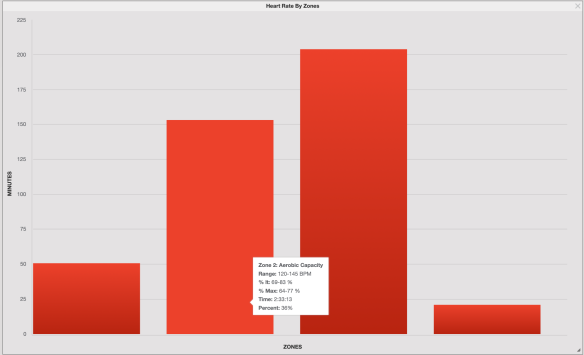
POWER DATA
Let’s now look at power data as a check and balance to HR data. I have always put more value in power data. It is less susceptible to the vagaries of HR such as fatigue, weather, dehydration, cardiac drift, bonking and other things.
I should give a quick class on w/kg. W/kg is an essential metric and universal. To calculate w/kg First you take your weight in pounds convert it to kg then take the power you sustained and divide it by your weight in kg. For example, my weight is 148 lbs, or 67.51 kg therefor 170 watts divided by 67.51 kg = 2.5 w/kg. I say it is universal because a 125 lb female and a 165 lb male can climb a hill and we can distinguish who is the faster stronger rider by looking at their w/kg even if they are in different states or different parts of the world. You know it this relationship as power to weight ratio. You have heard it for years. Now we have the equipment, power meters, to evaluate human performance as we have evaluated motorsports vehicles in the past.
Normalized Power (NP) for the ride was 170 watts. 170 watts is also 2.5 w/kg you can also see that IF .71 that means I was 71% of my Functional Threshold Power (FTP) FTP is the highest average power a rider can sustain for a 1 hour period.
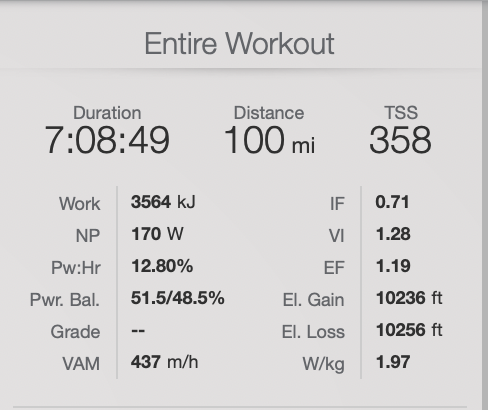
Zone 2 Endurance – for me is between 136-182 watts. I spent roughly 2 hours at Zone 2.

To keep things interesting Lori and I pushed the pace a little on some of the climbs to Zone 3, 183-218 watts. You can see from the chart above that I spent roughly 2 hours in Zone 3.
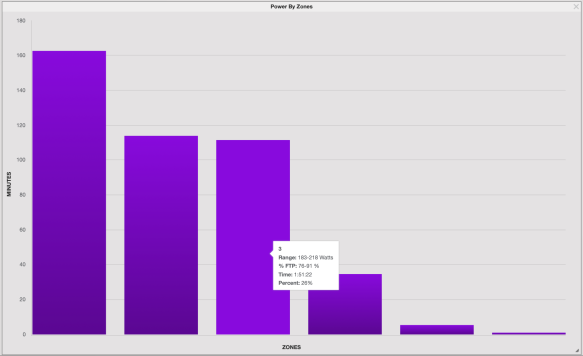
Let’s address the elephant in the room or the chart shall we? Zone 1, 0-134 watts it is a large bin and towers over all other zones, approximately 160 minutes. At first glance it may appear that, “geez this guy was not doing ANY work out there” If you clean up the chart by excluding Zeros and change the bin size to 50 watts. You will then see that 0-100 watts is barely 40 minutes of the ride and when climbing 10,000 plus feet on a ride guess what? – there is also 10,000 feet of descending as well which actually was more than 40 minutes total. Not to mention that there is no need to pedal when descending over 35mph. Here is a tidier version.
Power of 150-200 watts 38% of the time between 2.2 w/kg and 3.0 w/kg
Power of 200-250 watts 25% of the time between 3.0 w/kg and 3.7 w/kg
38+25 = 63% of the ride in the target power zones.
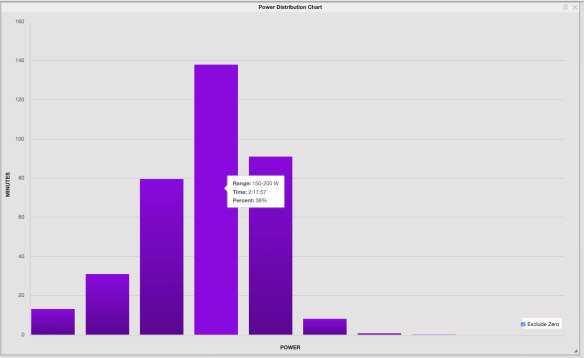
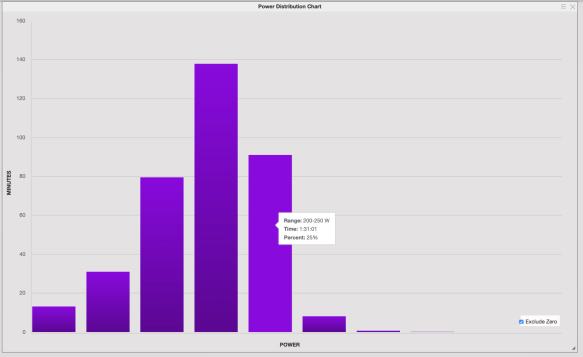
What are the key takeaways from this power data?
- Pacing with a power meter kept me from riding harder than the self-prescribed goal of the day.
- I spent roughly 4 hours of a 7 hour training ride in the ideal zones that I need to train at to sustain and perform well at the double centuries coming next month – Zone 2 and Zone 3
HOUR BY HOUR CUMULATIVE POWER DATA
Having looked at my power numbers for the entire ride let’s now analyze as the ride progressed how well I stuck to my training objective for the day.. What follows is an hour by hour data dump. You ready? Let’s go!

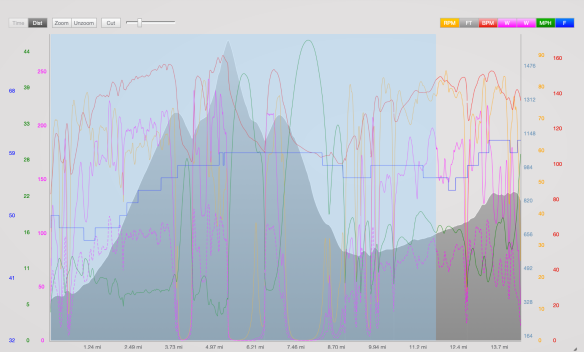
First hour 1 minute stopped time. NP 175 – 2.59 w/kg 11.8 miles with 1,556 feet of climbing
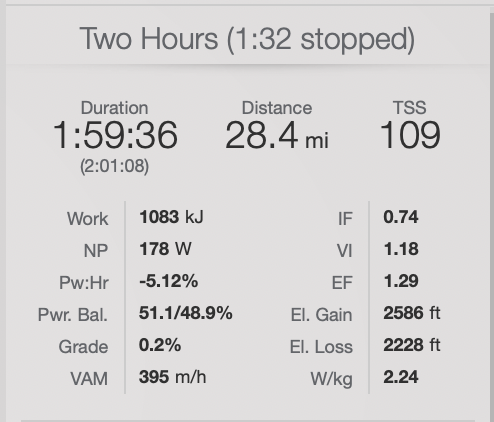

Two hours – NP 178 watts 2.63 w/kg 28.4 miles and 2,586 feet of climbing with only 1:32 stopped time.
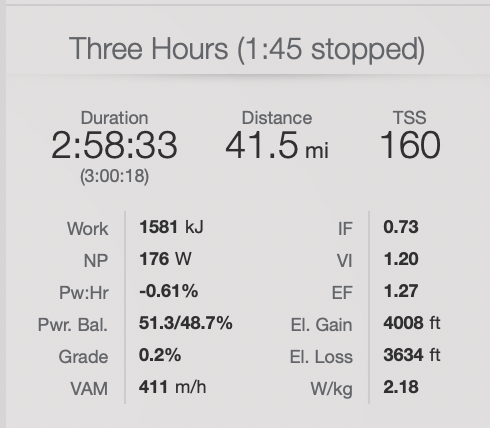

Three hours – NP 176 watts 2.60 w/kg 41.5 miles and 4,000 feet of climbing with only 1:32 stopped time.

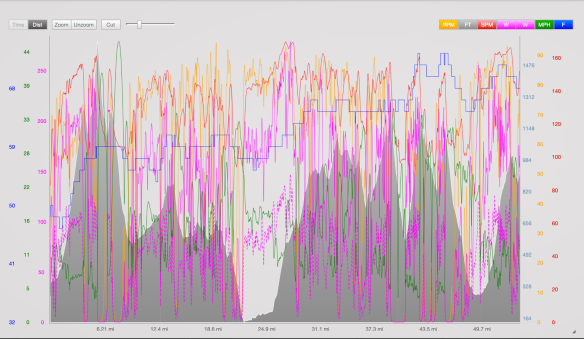
Four hours – NP 175 watts 2.59 w/kg 54.2 miles and 5,638 feet of climbing with only 2:11 stopped time.
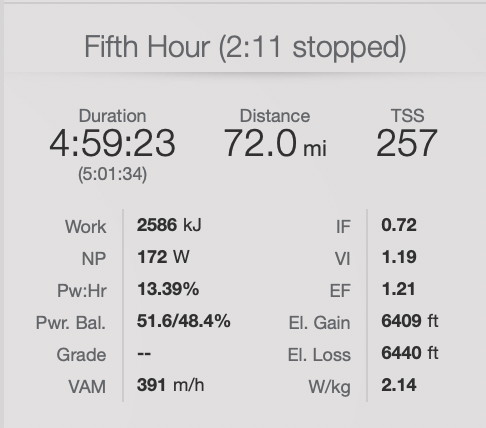
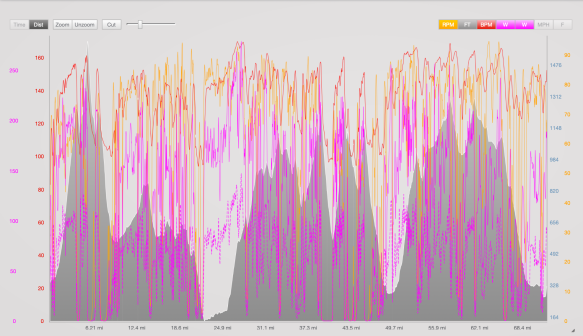
Five hours – NP 172 watts 2.54 w/kg 72.0 miles and 6,409 feet of climbing with only 2:11 stopped time. This is remarkable considering San Diego is one of the top ten urban cities in the US I was able to ride for 5 hours and have only had Two minutes of stopped time to traffic controls.


Six hours – NP 172 watts 2.54 w/kg 87.5 miles and 7,715 feet of climbing with only 7:37 stopped time. At this point in the ride we were heading back in to town and the lights that were green early in the morning when traffic was light were now not in our favor they were more red than green. Consider the fact that 2pm is busier than 8am and more motorists are out.
SOME INTERESTING DATA OF CLIMBS
Going from hour 5 to hour 6 there are two climbs of note, Sheers Grade (1.5 miles) and Champagne (2 miles) approximately mile 73.5 and mile 81, respectively.
Let’s look at those two hills in more detail. First images will show where they fall in the overall route and then they will be analyzed separately. Sheers grade comes first about mile 73.5 and then on the second image you can see Champagne at mile 81.
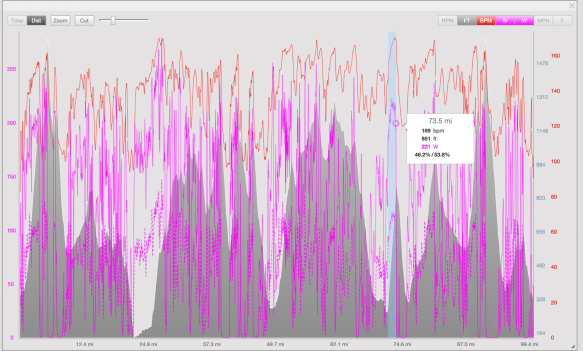
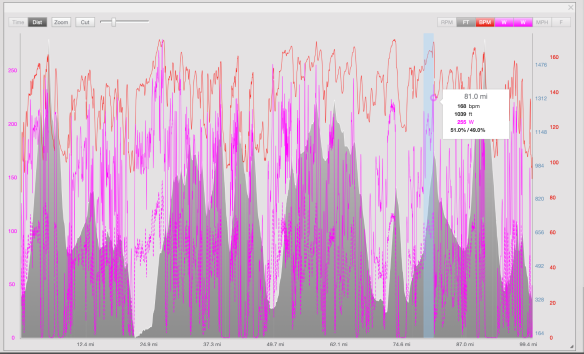
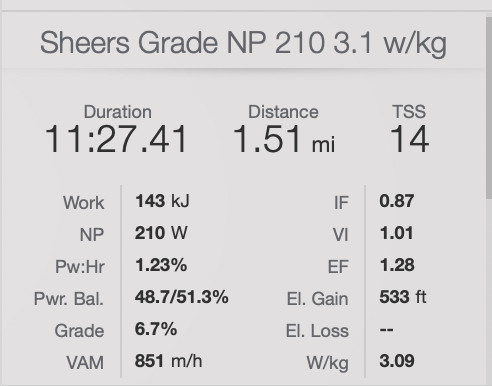
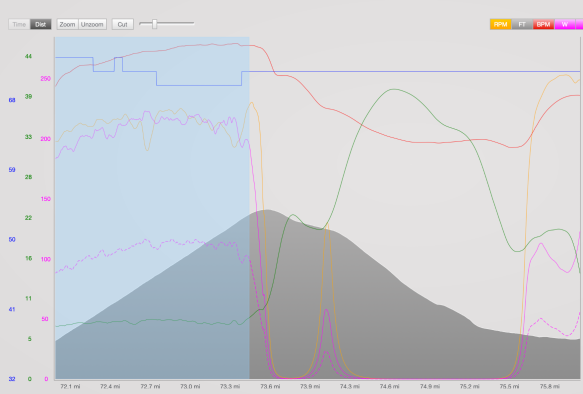
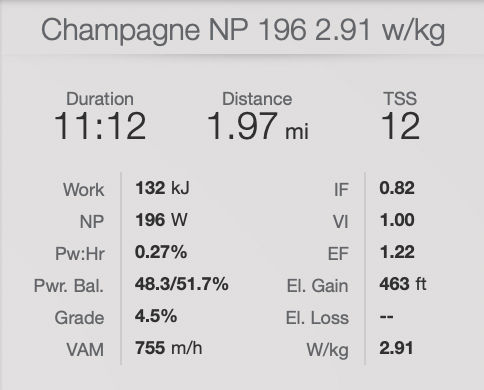
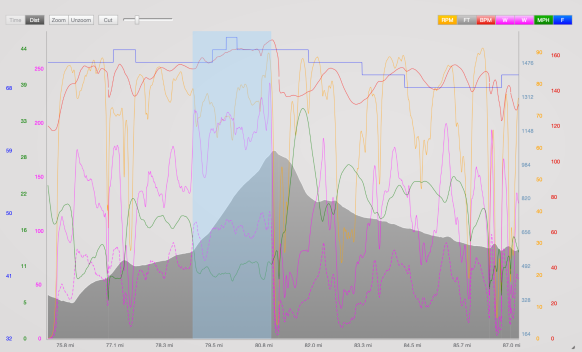
Sheers grade is a little steeper (~7% grade) and easy to ride it at a higher wattage. Champagne is not as steep (4.5% grade after a long approach) nor as steady of a grade.
THE LAST CLIMB IS ALL THAT MATTERS
I have always told my clients that the last climb is the only one that matters. It’s a REVism << things that I think that I came up with and live by on the bike.
Last climb of the day with over 9,000 feet on our legs and 6 plus hours on the bike, Twin Oaks and Double Peak. By the way, I have Everested these two climbs in the past. Everesting is 29,029 feet of climbing on one ride on one hill. You may want to make note of the minimal stopped time during a 29,000 foot climbing day less than one hour in both of these efforts. You may also want to take note of one more thing my average power for the 14 hours of riding was also in the 171 and 175 watts. Are you starting to see a pattern yet? I am a master at pacing my endurance rides or is it that using a power meter helps me to pace properly what do you think? Yeah you’re right it’s the power meter. GET ONE! I think I know a guy that owns a bike shop and get help you get sorted out hint hint.
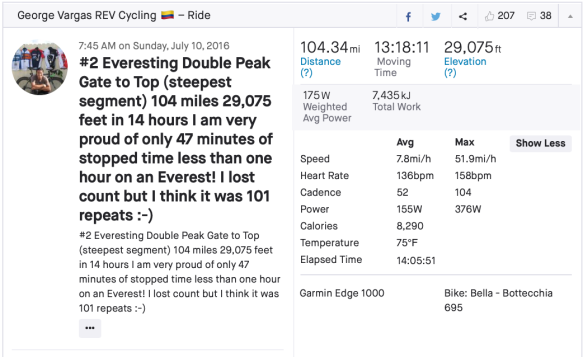
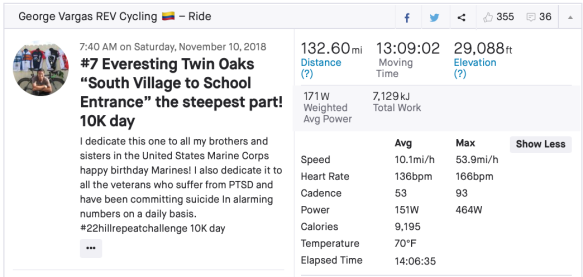
I digress here is the last climb err 2 climbs of the day.
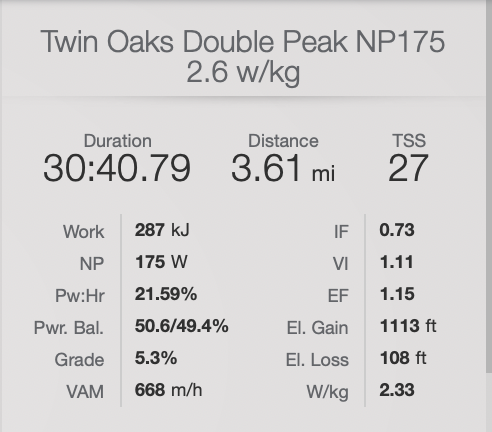
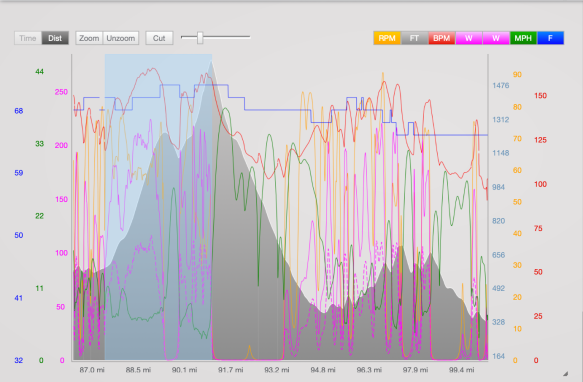
I climbed Twin Oaks and Double Peak at NP 175 2.6 w/kg (I know I was much lighter 7 hours into the ride but…) Take a look at the first hour of my ride with all these graphs it might have gotten lost in translation but here is the data “First hour 1 minute stopped time. NP 175 – 2.59 w/kg 11.8 miles with 1,556 feet of climbing” here is the takeaway I rode as strong in the last 30 minutes of the ride as I rode in the first 30 minutes of the ride 7 hours later with 10,000 feet of climbing on my legs without having stopped for refueling, more liquids or anything. All I had to drink on the entire ride was 16 oz of coffee.
SUMMARY OF THE DATA
First hour 1 minute stopped time. NP 175 – 2.59 w/kg 11.8 miles with 1,556 feet of climbing
Two hours – NP 178 watts 2.63 w/kg 28.4 miles and 2,586 feet of climbing with only 1:32 stopped time.
Three hours – NP 176 watts 2.60 w/kg 41.5 miles and 4,000 feet of climbing with only 1:32 stopped time.
Four hours – NP 175 watts 2.59 w/kg 54.2 miles and 5,638 feet of climbing with only 2:11 stopped time.
Five hours – NP 172 watts 2.54 w/kg 72.0 miles and 6,409 feet of climbing with only 2:11 stopped time.
Six hours – NP 172 watts 2.54 w/kg 87.5 miles and 7,715 feet of climbing with only 7:37 stopped time.
Seven hours – the data for the total ride as indicated earlier in this post. “Normalized Power (NP) for the ride was 170 watts. 170 watts is also 2.5 w/kg”
WHY DID I DO A NO NO RIDE?
When doing double centuries on a tandem there a few key strategies Lori and I employ and they are as follows:
- We minimized stopped time – because time off the bike is time you never get back
- We carry all our own nutrition so all we need is water from the aid stations – refer to #1
- We do not tarry at aid stations – we are cordial, always thank the volunteers but we grab it and go! Refer to #1
- We ride at a sustained effort for 10-14 hours for 10,000-17,000 feet of climbing with very little spikes in our efforts unless absolutely necessary.
- Stops for potty breaks or refueling are also held to a minimum. Refer to strategy #1
WHY DID I CREATE THIS POST
It always amazes me how people who know nothing about my cycling history make a mockery of my cycling exploits and experiments. I’ve been doing hard rides for years. I have been doing epic shit for years. I have been doing NO NO Rides for years. I used to call them depletion rides. These training rides were intended to drain me and then allow my body to heal itself through a theory of super compensation.
Way before social media existed and way before the “typewriter raider” was created. The guy or gal that knows it all and knows what is good for you and how your training methods are foolish and/or ill conceived. I have been testing the limits of my body, my endurance and my mental strength for going on 2 decades. Here is another REVism -train the brain it is the most important and powerful muscle in your body. But yes the typewriter raider the omniscient and often anonymous critic is a real thing. They’re out there just waiting to rain on your parade. It’s ok and in fact I have pity for them because I see them and have known them in real life to be people who when you say, “Wow what a beautiful day” they respond with, “Yeah but …” Many of the people who poo poo my efforts don’t know or take the time to discover who I am and what I have accomplished in my short but all in, no holds barred, Ultra Cycling career. It is for that small segment of naysayers that sometimes I need to spend a few minutes to educate them, as well as the public at large, about how amazing our bodies are and how they can achieve superhuman feats of endurance … if you just HTFU!
Thank you for taking the time to read my blog. You can find me onStrava Instagram Twitter youtube
You may also want to read about 8.5 hour fasted ride.

Super interesting! Thanks for sharing, George!
Hello Jason thank you for taking the time to read my blog! I appreciate your support! We need to get a power meter for your bike so you can have all sorts of cool graphs too lol!
George, what power meter do you use?
Hello Nick thank you for reading my blog. Thank you for taking the time to post your inquiry. I use a couple of power meters. Most of the time I use a pedal based system from Favero – super reliable! I also use an SRM. Are you in the market for a power meter! I sell all the major brands of power meters.
Yes, but have to figure out how to convince the Mrs. I need one. What would a single Favero run me George? (I hope I haven’t responded twice).
$499 single sir! Please contact me via email “revcycling@gmail.com” with your questions and concerns I don’t always notifications on my blog. Not to mention Instagram, Twitter, Facebook, Facebook messenger, Instagram messenger, and text messages and so on 🤣😂
Here you go Nick! Pedals have been known to slip under the radar of the significant other 😉 https://www.revendurancesports.com/favero-assioma-power-meter-pedals.html